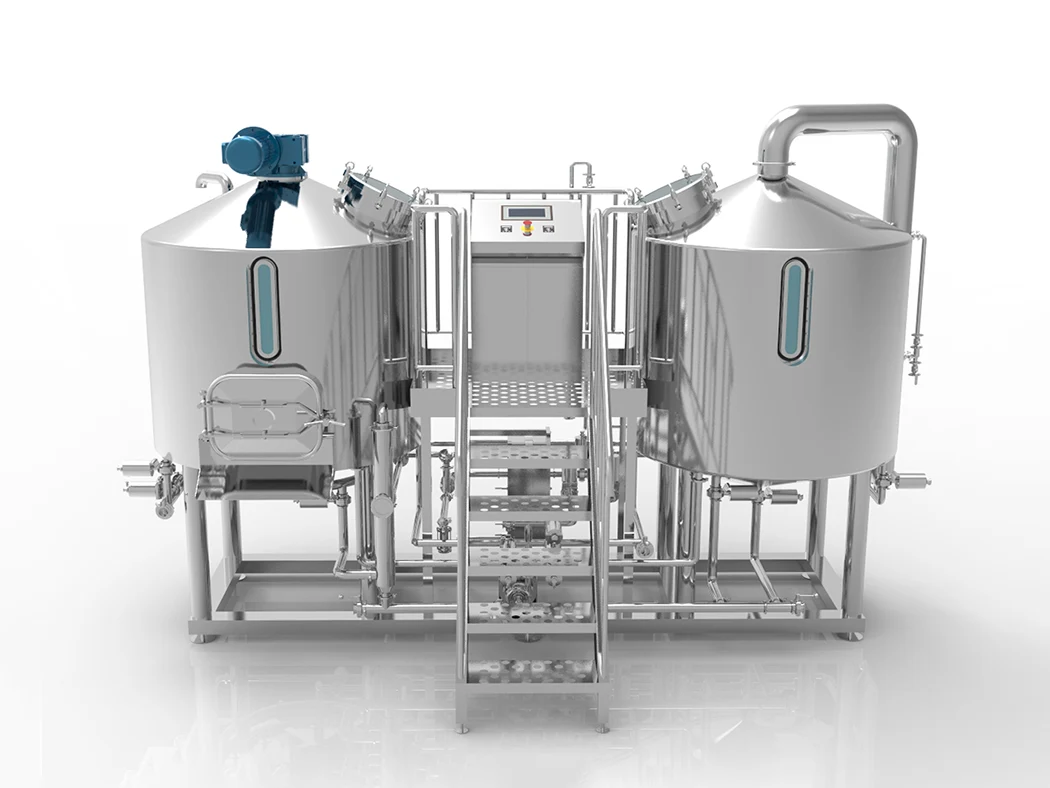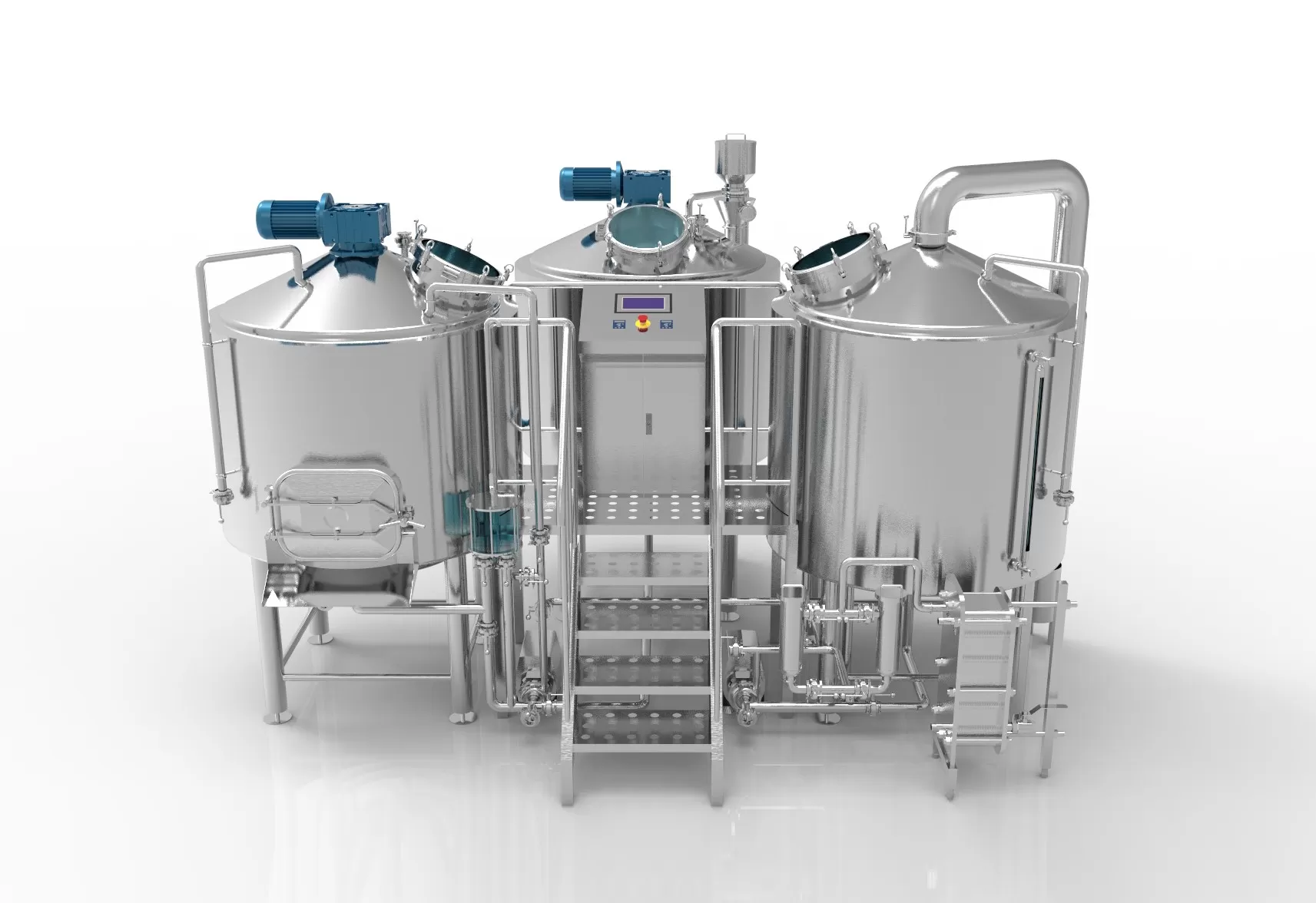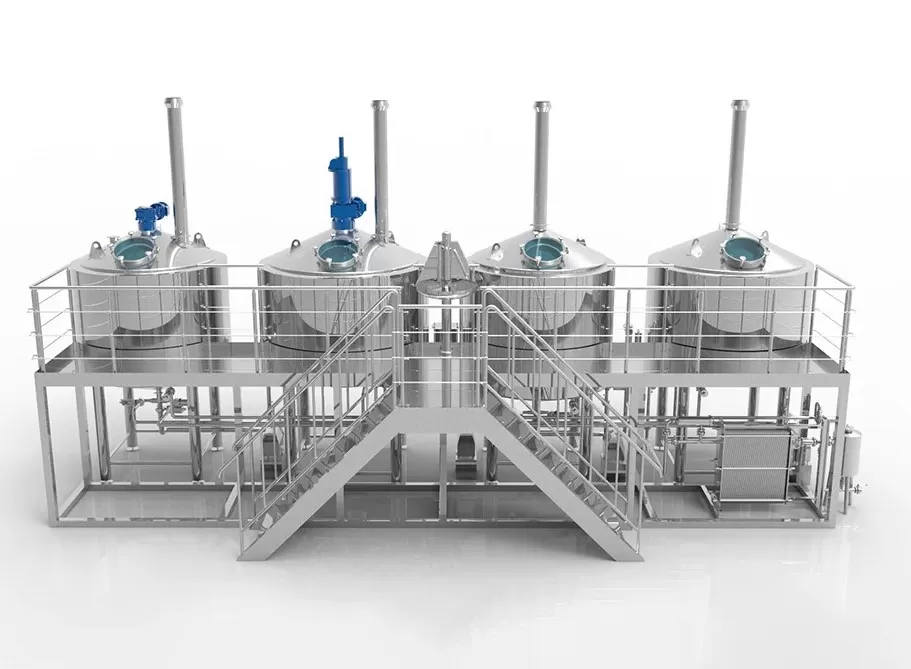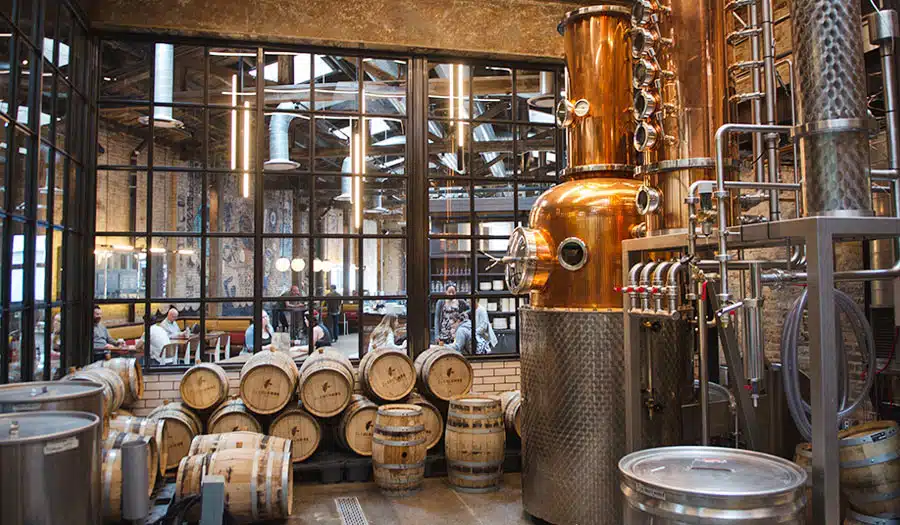Viele Brauereien und handwerklich arbeitende Hersteller haben Schwierigkeiten, ihren Betrieb zu skalieren, weil ihre Anlagen veraltet sind, ihre Produktionsflexibilität begrenzt ist oder sie keinen zuverlässigen Lieferanten haben. Ohne die richtigen Werkzeuge können selbst hochwertige Rezepte die Erwartungen des Marktes nicht erfüllen.
Die Ausrüstung für Bierbrennereien umfasst die Brau- und Destillieranlagen, die zur Herstellung von Bier, Whiskey und anderen handwerklichen Getränken verwendet werden. Dazu gehören Brausysteme, Gärbehälter, Destillierapparate, Maischebottiche und Temperaturregelungseinheiten für die Herstellung kleiner Mengen und die gewerbliche Produktion.
Was ist eine Bierdestillerie-Ausrüstung?
Die Ausrüstung einer Bierbrennerei bezieht sich auf die integrierten Maschinen, die für die Brauen und Destillieren von Bier und Spirituosen. Dies umfasst eine breite Palette von Komponenten, von Maischebottiche Und Fermenter zu Destillierapparat, Wasserkocherund Kontrollsysteme, die eine präzise Regulierung von Temperatur und Flüssigkeitsdurchfluss ermöglichen. Ob für eine Brauerei, Kleinbrauereioder eine Mischform Bier- und DestillieranlageDie richtige Ausrüstung ist entscheidend für die Produktion Qualitätsbier oder Spirituosen wie Whiskey.
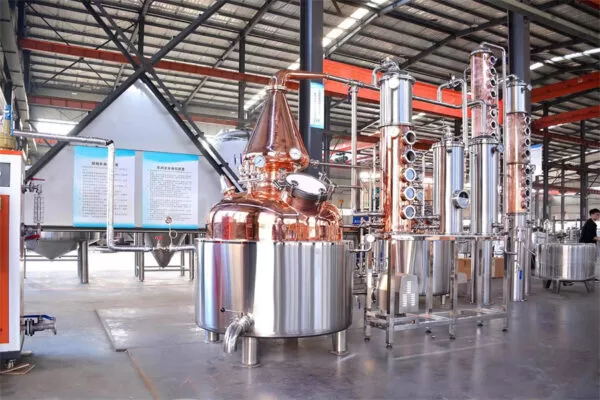
Die am häufigsten verwendeten Brauereiausrüstung in Destillerien umfasst:
-
Brühsysteme aus rostfreiem Stahl
-
Maischebottiche und Läuterbottiche
-
Gärbehälter
-
Pot Stills und Reflux Stills
-
Kessel und Heizquellen
-
Kühlung und Kühlaggregate
-
Sanitärarmaturen Und Filtersysteme
-
Glänzende Tanks zur Karbonisierung und Veredelung
Eine moderne Destillerie muss Hygiene, Prozessautomatisierung und Energieeffizienz gewährleisten. Deshalb bevorzugen viele professionelle Betriebe 304 Edelstahl Die Konstruktion ist leicht zu reinigen, korrosionsbeständig und entspricht den Normen für Lebensmittel. High-End Bierbrauausrüstung ist oft für einen doppelten Zweck konzipiert und unterstützt sowohl handwerkliches Brauen Und Destillation Prozesse mit Flexibilität.
Was sind die wichtigsten Komponenten eines modernen Brühsystems?
Eine vollständige Brühsystem besteht aus mehreren Hauptkomponenten, die zusammenwirken, um Getreide in Bier zu verwandeln. Bei Brennereien, die auch Spirituosen herstellen, dient dieses System oft auch als erste Stufe der Destillationsverfahren.
| Komponente | Funktion |
|---|---|
| Maischebottich | Umwandlung von Malz und Wasser in vergärbaren Zucker (Maische) |
| Kessel | Kochen der Würze und Hinzufügen von Hopfen oder anderen Aromastoffen |
| Fermenter | Wirt Hefeaktivität zur Umwandlung von Zucker in Alkohol |
| Wärmetauscher | Kühlt die Würze vor Beginn der Gärung schnell ab |
| Glykol-Kühler | Hält die Temperaturen während der Gärung niedrig |
| Bedienfeld | Regelt Temperatur, Pumpendurchfluss und Chargenzeitgeber |
Dieser Aufbau wird oft als Sudhausund ist von zentraler Bedeutung für das Funktionieren eines jeden Brauerei oder handwerkliche Schnapsbrennerei. It’s not just the tank count that matters—efficiency, heat transfer speed, and the ability to integrate with Destillieranlage sind für eine langfristige Skalierbarkeit unerlässlich.
Für diejenigen, die sowohl Bier als auch Spirituosen herstellen wollen, sind zusätzliche Komponenten wie Standbilder, Destillationskolonnenund Filtrationseinheiten sind in den Entwurf integriert, um den Übergang von Brauen zu Destillieren ohne Einbußen bei der Produktqualität oder dem Ertrag.
Wie funktioniert die Destillieranlage in einer Brauerei?
Bei hybriden Operationen, Destillieranlage ergänzt die Brühsystem indem sie die Umwandlung von vergorenem Bier in destillierte Spirituosen ermöglicht. Dieses Crossover-Verfahren wird immer beliebter bei Handwerksbrauereien Und Kleinmengen-Brennereien die ihre Produktpalette erweitern wollen.
Die gebräuchlichsten Arten von Destilliergeräten sind:
-
Destillierapparat - ideal für geschmackvolle Spirituosen wie Whiskey oder Rum
-
Standbilder der Säule - verwendet für sauberere Spirituosen wie Wodka
-
Rückflussdestillate - ermöglichen eine kontrollierte Trennung von Alkohol und Dampfreinheit
-
Air Still Pro - geeignet für kleinere, einsteigerfreundliche Produktionen
-
Destillationskits - modulare Systeme für Versuche oder Heimdestillation
In einer Brauerei, die sich auch mit Destillation, Hefe aus dem Gärung Stufe bleibt in der Maische aktiv, die dann in einen Kessel überführt wird. immer noch. Die Brenner den Erhitzungsprozess sorgfältig kontrolliert, so dass der Alkohol verdampfen und gehen durch die Spaltewo es kondensiert und gesammelt wird als Destillat.
Dieses System ermöglicht es:
-
Effiziente Nutzung von Brauen und Destillieren Vermögenswerte
-
Volle Geschmackskontrolle in Kleinserie Spirituosen
-
Besserer ROI durch Wiederverwendung der Fermentationsinfrastruktur
-
Die Produktion von Whiskey, Mondscheinoder andere handelsübliche Spirituosen
Was ist der Unterschied zwischen Brauen und Destillieren?
Bei beiden Verfahren werden zwar die Rohstoffe in Alkohol umgewandelt, Brauen Und Destillieren unterscheiden sich grundlegend in Zweck, Methode und Ergebnis. Das Verständnis dieses Unterschieds ist für jeden, der eine Hybridanlage betreibt, unerlässlich.
Brauen
-
Umwandlung des Zuckers aus Malz in Alkohol durch Gärung
-
Führt zu Getränken wie Bier, die einen geringeren Alkoholgehalt haben (typischerweise 4-8%)
-
Verwendet Geräte wie Maischebottiche und Gärbehälter, Wasserkocherund Kältemaschinen
-
Erfordert präzise Hefe-ManagementTemperaturkontrolle und Abwasserentsorgung
Destillieren
-
Entnahme der vergorenen Flüssigkeit (bekannt als "Lauge" oder "Bier") und Abtrennung des Alkohols durch Hitze und Kondensation
-
Führt zu hochprozentigen Spirituosen wie Whiskey, Wodka, oder Mondschein
-
Verlässt sich auf Standbilder, Rückflusssäulenund Kondensatoren
-
Häufig mit Alterung verbunden (z. B. in Eichenfässer) für die Geschmacksentwicklung
Während es beim Brauen um die Ausgewogenheit der Zutaten geht, geht es beim Destillieren um die Verfeinerung von Reinheit und Stärke. Viele moderne Anlagen erfüllen beide Aufgaben mit Hilfe modularer Systeme, die es ermöglichen, zwischen den Produktionsarten zu wechseln.
Welche Materialien eignen sich am besten für die Ausrüstung von Bierbrennereien?
Die Auswahl des Materials spielt sowohl für die Hygiene als auch für die Leistung eine entscheidende Rolle. Die beiden am häufigsten verwendeten Materialien in professionellen Brau- und Destillieranlagen sind rostfreier Stahl Und Kupfer.
| Material | Vorteile | Anwendungen |
|---|---|---|
| Rostfreier Stahl | Langlebig, hygienisch, korrosionsbeständig | Biertanks, Gärbehälter, Kältemaschinen |
| Kupfer | Ausgezeichnete Wärmeleitfähigkeit, beseitigt Schwefel | Destillierapparate, Brüdenwege, Kondensatoren |
| Glas/Kunststoff | Selten im professionellen Einsatz; verwendet in Selbstdestillation | Einsteiger-Kits, Testaufbauten |
Die meisten modernen Brauereianlagen aus rostfreiem Stahl wird hergestellt aus 304 Edelstahldas ein ideales Gleichgewicht zwischen Festigkeit, Korrosionsbeständigkeit und Lebensmittelzulassung bietet. Bei der Destillation, Kupferkessel werden oft in Kombination mit Tanks aus rostfreiem Stahl verwendet, um die Vorteile beider Materialien zu nutzen.
Für Einrichtungen, die Wert auf geringen Wartungsaufwand, Konformität und Skalierbarkeit legen, sind vollständige Systeme aus rostfreiem Stahl sind in der Regel die bevorzugte langfristige Investition.
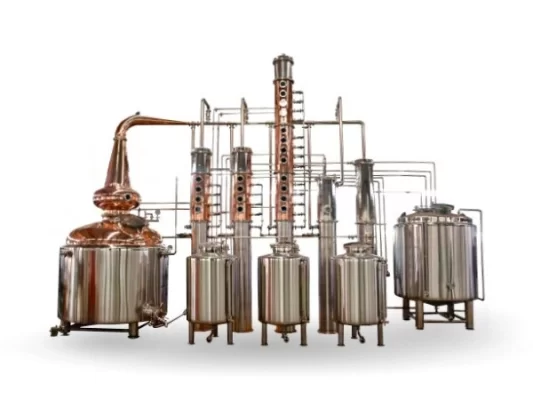
Wie Sie die richtige Ausrüstung für Ihre Brauerei oder Destillerie auswählen
Bei der Auswahl der richtigen Ausrüstung geht es um viel mehr als nur um die Auswahl von Tankgrößen oder Destillationstypen. Eine erfolgreiche Investition berücksichtigt die Produktionsziele, die räumlichen Gegebenheiten, die Vielfalt der Spirituosen und die örtlichen Vorschriften.
Lassen Sie uns ein Beispielszenario durchgehen:
Eine kleine städtische Brauerei, die 10-Fass-Chargen produziert, möchte ein handwerklich hergestellter Whiskey Linie. Sie installieren eine 150-Gallonen-Kupferbrennblase mit einer 3-Platten Rückflusssäuleund teilt sich die Glykolkühlung und das Bedienfeld mit dem bestehenden Sudhaus. Diese Integration spart 30% Installationskosten und ermöglicht einen flexiblen Wechsel zwischen Bierbrauen Und Destillieren ohne ihren Aktionsradius zu erweitern.
Wichtige Überlegungen für die Auswahl:
-
Volumen pro Charge: 100, 150, 300, oder 500 Gallonen
-
Art der Spirituose: Whiskey braucht Pot Stills, Wodka bevorzugt Refluxkolonnen
-
Heizverfahren: Elektrisch, dampf- oder gasbeheizt
-
Automatisierung: Manuell vs. halbautomatisch vs. PLC-Touchscreen
-
Reinigung: Ob Sie CIP-fähige Tanks und sanitäre Ventilsysteme benötigen
Durch die Zusammenarbeit mit einem erfahrenen Anbieter der versteht Ausrüstung für handwerkliches Brauen und Destillationssystemen vermeiden Sie kostspielige Umgestaltungen und erhalten Unterstützung bei Zertifizierungen, Layoutplanung und zukünftigen Upgrades.
Was sind die Vorteile von Edelstahl beim Brauen und Destillieren?
Edelstahl ist das Material der Wahl für moderne Brauerei- und Destillationsanlagen, da es robust, hygienisch und für eine Vielzahl von Temperaturen und Verfahren geeignet ist.
Warum rostfreier Stahl unverzichtbar ist:
-
Hygienisch: Die porenfreie Oberfläche ist resistent gegen mikrobielle Ablagerungen und ermöglicht eine einfache und effektive Reinigung.
-
Dauerhaft: Hält wiederholten Heiz- und Kühlzyklen stand, ohne sich zu verformen oder Risse zu bekommen.
-
Konform: Erfüllt die Hygienestandards für die Verarbeitung von Lebensmitteln und Getränken.
-
Korrosionsbeständig: Geeignet für säurehaltige Umgebungen, die bei Gärung und Destillation.
Die meisten Bierbrauausrüstung Und Destillieranlage wird hergestellt aus 304 Edelstahldas ein ideales Gleichgewicht zwischen Kosten, Korrosionsbeständigkeit und Schweißbarkeit bietet. Für höhere Beständigkeit oder korrosive Anwendungen verwenden einige Systeme Edelstahl 316-Dies ist jedoch eher bei Systemen in pharmazeutischer Qualität üblich.
Das ist wichtig, Tanks aus rostfreiem StahlKessel und Rohrleitungssysteme unterstützen die Integration mit CIP (Clean-in-Place) und Sanitärarmatur Netze, wodurch die manuelle Arbeit reduziert und gleichzeitig die Konsistenz in Brauen Und Destillieren Umgebungen.
Welche Rolle spielt die Gärung beim Brennen von Bier zu Spirituosen?
Bevor eine Flüssigkeit destilliert werden kann, muss sie zunächst vergoren werden. Die Fermentationsprozess wird der Zucker aus dem gemälzten Getreide in Alkohol umgewandelt, indem HefeSie bildet die Basisflüssigkeit - gemeinhin als "Bier" oder "Wäsche" bezeichnet -, die später in die Brennerei geleitet wird. immer noch.
Übersicht über die Fermentierung:
-
Maischen wandelt Stärke in vergärbaren Zucker um
-
Die Würze wird gekühlt und in einen Fermenter
-
Hefe wird angekippt und beginnt mit der Umwandlung von Zucker in Ethanol und CO₂.
-
Nach einigen Tagen entsteht durch Gärung eine Flüssigkeit mit 6-10% Alkohol
-
Diese Flüssigkeit wird dann in einem Destillierapparat oder Spalte noch für die Destillation
In einem Nur zum Brühen wird das Produkt gefiltert und mit Kohlensäure versetzt. Unter Destillationwird er weiterverarbeitet, um Alkohol zu extrahieren und zu reinigen. Die Temperaturregelung, die Auswahl des Hefestamms und die Dauer der Gärung wirken sich alle auf die endgültige DestillatGeschmack, Ertrag und Alkoholgehalt des Weines.
Die Gärung ist nicht nur die Brücke zwischen Brauen und Destillieren - sie bestimmt auch den Grundcharakter Ihrer Spirituosen. Eine schlecht geführte Gärung führt zu schwachen oder fehlerhaften Spirituosen, egal wie fortschrittlich Ihr Destillationsanlage ist.
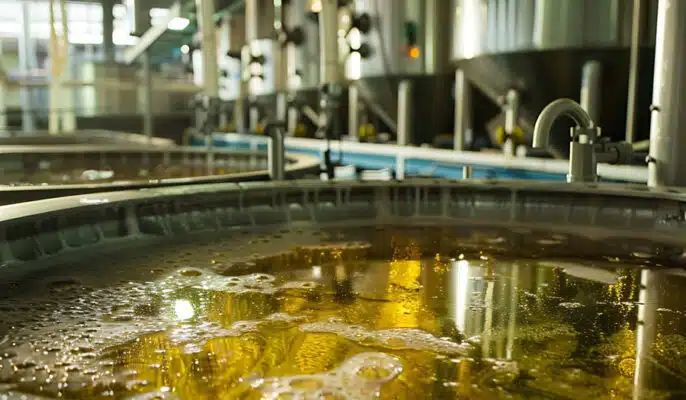
Wie expandieren Craft-Brauereien in den Brennereisektor?
Viele Handwerksbrauereien versuchen, ihr Portfolio um Spirituosen zu erweitern, wie Whiskey, Wodka, oder Gin zu ihren Angeboten. Diese Umstellung umfasst in der Regel die Installation zusätzlicher Destillieranlage und die Umgestaltung eines Teils des Sudhauses zur Doppelnutzung.
Anstatt von Grund auf neu zu bauen, rüsten die Brauereien ihre bestehenden Systeme oft mit neuen Geräten auf:
-
Modulare Brennblasen mit gemeinsamer Dampf- oder Elektroheizung
-
Rücklaufsäulen zur Herstellung hochprozentiger Spirituosen
-
Separate Fermenter für Wäsche vs. Bier
-
Eine engagierte Filtrierung Und Kühlung Linie für destillierte Produkte
-
Regulierungsberatung für die Lizenzierung von Spirituosen und die Einhaltung von Vorschriften
Fallbeispiel:
Eine 5.000-Liter-Brauerei verwendet einen 300-Gallonen-Destillierapparat mit einer Rückflusssäule und integriert es in ihre bestehenden Glykol-Kühlung Schleife. Sie stellen drei Gärbehälter für Bier und einen für Spirituosen zur Verfügung. Die Spirituosen werden unter einem Sublabel vermarktet, wodurch ein neues Kundensegment erschlossen und die Gewinnspanne erhöht wird.
Mit dem richtigen Brauerei- und Destillieranlagenkönnen die Brauereien den Spirituosenmarkt mit minimaler Störung testen. Die Nachfrage nach handwerkliches Getränk Die Vielfalt nimmt weiter zu, und Hybridbrauereien können diese Nachfrage effizient befriedigen.
Was macht einen guten Lieferanten von Brauerei- und Destillationsanlagen aus?
Die Wahl des richtigen Gerätehersteller oder Anbieter kann über Ihr Geschäft entscheiden. Sie kaufen nicht nur Hardware, sondern auch Erfahrung, Anpassungsmöglichkeiten und langfristigen Support.
Die wichtigsten Eigenschaften, auf die Sie achten sollten:
-
Schlüsselfertige Lösungen: Vom Sudhauslayout bis zur Installation und Schulung
-
Personalisierung: Die Fähigkeit, Schiffe maßzuschneidern, Ventilsystemeund Automatisierung
-
Globale Zertifizierungen: CE, UL, 3A-Konformität, etc.
-
Unterstützung nach dem Verkauf: Zugang zu Ersatzteilen, Upgrades und Ferndiagnose
-
Erleben Sie: Bewährte Lieferung an Brauereien und handwerkliche Brennereien weltweit
Micet ist spezialisiert auf die Bereitstellung maßgeschneiderte Lösungen für Neugründungen, wachsende Produzenten und etablierte Unternehmen gleichermaßen. Ob Sie benötigen neu und gebraucht Ausrüstung, ein Dual-Purpose-System oder eine vollständige gewerbliches Brauen und Destillationsanlagen helfen wir bei der Entwicklung und Lieferung zuverlässiger, zertifizierter Systeme, die sich an Ihre Bedürfnisse anpassen.
Häufig gestellte Fragen
Was ist der Unterschied zwischen dem Bierbrauen und dem Brennen von Spirituosen?
Beim Brauen wird Zucker durch Gärung in Alkohol umgewandelt, um Bier herzustellen, während beim Destillieren die vergorene Flüssigkeit erhitzt wird, um den Alkohol abzutrennen und zu reinigen und so hochprozentige Getränke wie Whiskey oder Wodka herzustellen.
Welche Brennereigröße sollte ich für die Destillation kleiner Mengen verwenden?
Für die Produktion von Kleinserien, 150-Gallonen-Brennblasen oder Spalte Standbilder sind ideal. Sie bieten ein ausgewogenes Verhältnis zwischen Leistung und Geschmackskontrolle und lassen sich gut in Mikrobrauereien oder Hybridbrausysteme integrieren.
Kann ich für das Brauen und Destillieren dieselben Geräte verwenden?
Ja, viele Komponenten wie z. B. Maischebottiche, Fermenterund Wasserkocher geteilt werden können. Zusätzlich Destillieranlage wie Standbilder und Rückflusssäulen für die Herstellung von Spirituosen zugesetzt werden.
Welches Material eignet sich am besten für Destilliergeräte?
Rostfreier Stahl ist ideal für Haltbarkeit und Hygiene, während Kupfer wird häufig in Destillierapparaten verwendet, um das Aroma von Spirituosen zu verbessern und Schwefelverbindungen aus den Dämpfen zu entfernen.
Wie wichtig ist die Glykolabkühlung im Prozess?
Glykolsysteme helfen bei der Aufrechterhaltung präziser Temperaturen während Gärung und sind entscheidend für die Kontrolle der Hefeaktivität und die Abkühlung nach dem Kochen.
Welche Rolle spielt ein Wärmetauscher beim Brauen?
A Wärmetauscher rapidly cools wort after boiling, preparing it for fermentation. It’s essential for minimizing bacterial contamination and protecting Lebensfähigkeit der Hefe.
Wichtigste Erkenntnisse
-
Ausrüstung für Bierbrennereien umfasst Brausysteme, Destillierapparate, Gärbehälter, Filtrations- und Kühlkomponenten.
-
Verstehen des Unterschieds zwischen Brauen Und Destillieren hilft bei der Gestaltung einer effizienten Einrichtung mit doppeltem Verwendungszweck.
-
Rostfreier Stahl bietet Haltbarkeit, Hygiene und Konformität für die Bier- und Spirituosenherstellung.
-
Gärung ist das entscheidende Bindeglied zwischen dem Brauen und dem Destillieren; sein Management bestimmt die Produktqualität.
-
Partnerschaften mit den richtigen Anbieter gewährleistet skalierbare, regelkonforme und langlebige Systeme.
Letzter Gedanke
Whether you’re a craft brewer looking to add small batch spirits, a distillery scaling into beer production, or a new venture seeking reliable brewing and DestillieranlageDie Wahl des Systems wirkt sich auf alles aus, vom Geschmack bis zur Einhaltung der Vorschriften.
Micet bietet seinen Kunden weltweit hochwertige, anpassbares Brühen und Destillationsanlagen, built with precision craftsmanship and supported by technical expertise. Let us help you design a beer and distillery equipment solution that grows with your ambition.

